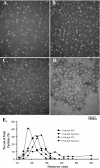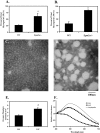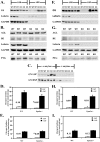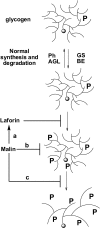Abnormal metabolism of glycogen phosphate as a cause for Lafora disease
- PMID: 18852261
- PMCID: PMC2590708
- DOI: 10.1074/jbc.M807428200
Abnormal metabolism of glycogen phosphate as a cause for Lafora disease
Abstract
Lafora disease is a progressive myoclonus epilepsy with onset in the teenage years followed by neurodegeneration and death within 10 years. A characteristic is the widespread formation of poorly branched, insoluble glycogen-like polymers (polyglucosan) known as Lafora bodies, which accumulate in neurons, muscle, liver, and other tissues. Approximately half of the cases of Lafora disease result from mutations in the EPM2A gene, which encodes laforin, a member of the dual specificity protein phosphatase family that is able to release the small amount of covalent phosphate normally present in glycogen. In studies of Epm2a(-/-) mice that lack laforin, we observed a progressive change in the properties and structure of glycogen that paralleled the formation of Lafora bodies. At three months, glycogen metabolism remained essentially normal, even though the phosphorylation of glycogen has increased 4-fold and causes altered physical properties of the polysaccharide. By 9 months, the glycogen has overaccumulated by 3-fold, has become somewhat more phosphorylated, but, more notably, is now poorly branched, is insoluble in water, and has acquired an abnormal morphology visible by electron microscopy. These glycogen molecules have a tendency to aggregate and can be recovered in the pellet after low speed centrifugation of tissue extracts. The aggregation requires the phosphorylation of glycogen. The aggregrated glycogen sequesters glycogen synthase but not other glycogen metabolizing enzymes. We propose that laforin functions to suppress excessive glycogen phosphorylation and is an essential component of the metabolism of normally structured glycogen.
Figures







Similar articles
-
Genetic depletion of the malin E3 ubiquitin ligase in mice leads to lafora bodies and the accumulation of insoluble laforin.J Biol Chem. 2010 Aug 13;285(33):25372-81. doi: 10.1074/jbc.M110.148668. Epub 2010 Jun 10. J Biol Chem. 2010. PMID: 20538597 Free PMC article.
-
Laforin is a glycogen phosphatase, deficiency of which leads to elevated phosphorylation of glycogen in vivo.Proc Natl Acad Sci U S A. 2007 Dec 4;104(49):19262-6. doi: 10.1073/pnas.0707952104. Epub 2007 Nov 26. Proc Natl Acad Sci U S A. 2007. PMID: 18040046 Free PMC article.
-
Impaired malin expression and interaction with partner proteins in Lafora disease.J Biol Chem. 2024 May;300(5):107271. doi: 10.1016/j.jbc.2024.107271. Epub 2024 Apr 7. J Biol Chem. 2024. PMID: 38588813 Free PMC article.
-
Pathogenesis of Lafora Disease: Transition of Soluble Glycogen to Insoluble Polyglucosan.Int J Mol Sci. 2017 Aug 11;18(8):1743. doi: 10.3390/ijms18081743. Int J Mol Sci. 2017. PMID: 28800070 Free PMC article. Review.
-
Are there errors in glycogen biosynthesis and is laforin a repair enzyme?FEBS Lett. 2011 Oct 20;585(20):3216-8. doi: 10.1016/j.febslet.2011.09.009. Epub 2011 Sep 16. FEBS Lett. 2011. PMID: 21930129 Free PMC article. Review.
Cited by
-
Glycogen and its metabolism: some new developments and old themes.Biochem J. 2012 Feb 1;441(3):763-87. doi: 10.1042/BJ20111416. Biochem J. 2012. PMID: 22248338 Free PMC article. Review.
-
Dimerization of the glucan phosphatase laforin requires the participation of cysteine 329.PLoS One. 2013 Jul 26;8(7):e69523. doi: 10.1371/journal.pone.0069523. Print 2013. PLoS One. 2013. PMID: 23922729 Free PMC article.
-
Lafora disease offers a unique window into neuronal glycogen metabolism.J Biol Chem. 2018 May 11;293(19):7117-7125. doi: 10.1074/jbc.R117.803064. Epub 2018 Feb 26. J Biol Chem. 2018. PMID: 29483193 Free PMC article. Review.
-
PTG depletion removes Lafora bodies and rescues the fatal epilepsy of Lafora disease.PLoS Genet. 2011 Apr;7(4):e1002037. doi: 10.1371/journal.pgen.1002037. Epub 2011 Apr 28. PLoS Genet. 2011. PMID: 21552327 Free PMC article.
-
Wdfy3 regulates glycophagy, mitophagy, and synaptic plasticity.J Cereb Blood Flow Metab. 2021 Dec;41(12):3213-3231. doi: 10.1177/0271678X211027384. Epub 2021 Jun 29. J Cereb Blood Flow Metab. 2021. PMID: 34187232 Free PMC article.
References
-
- Roach, P. J. (2002) Curr. Mol. Med. 2 101–120 - PubMed
-
- Ball, S., Guan, H. P., James, M., Myers, A., Keeling, P., Mouille, G., Buleon, A., Colonna, P., and Preiss, J. (1996) Cell 86 349–352 - PubMed
-
- Gunja-Smith, Z., Marshall, J. J., Mercier, C., Smith, E. E., and Whelan, W. J. (1970) FEBS Lett. 12 101–104 - PubMed
-
- Shearer, J., and Graham, T. E. (2004) Exerc. Sport Sci. Rev. 32 120–126 - PubMed
-
- Lomako, J., Lomako, W. M., Whelan, W. J., and Marchase, R. B. (1993) FEBS Lett. 329 263–267 - PubMed
Publication types
MeSH terms
Substances
Grants and funding
LinkOut - more resources
Full Text Sources
Molecular Biology Databases

